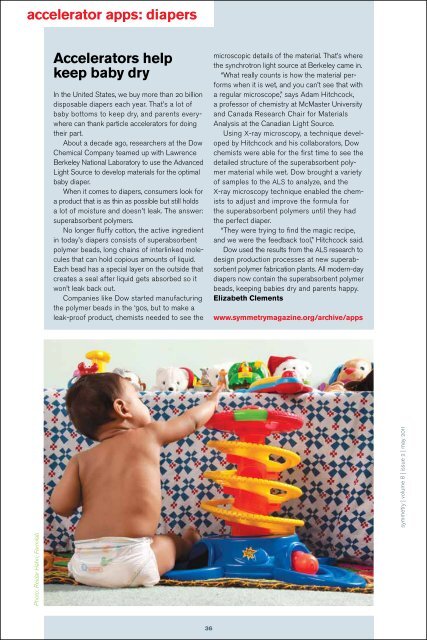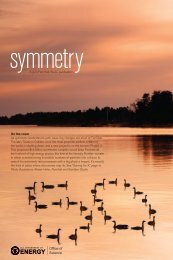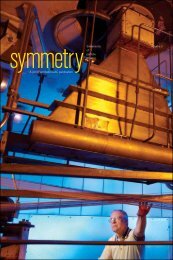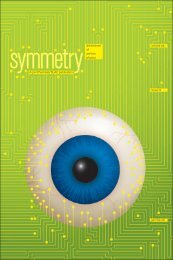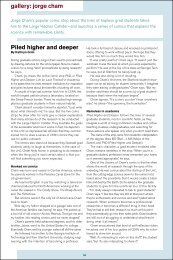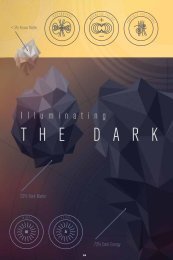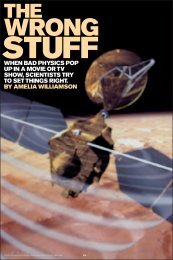pdf of the issue - Symmetry Magazine
pdf of the issue - Symmetry Magazine
pdf of the issue - Symmetry Magazine
Create successful ePaper yourself
Turn your PDF publications into a flip-book with our unique Google optimized e-Paper software.
accelerator apps: diapers<br />
Photo: Reidar Hahn, Fermilab<br />
Accelerators help<br />
keep baby dry<br />
In <strong>the</strong> United States, we buy more than 20 billion<br />
disposable diapers each year. That’s a lot <strong>of</strong><br />
baby bottoms to keep dry, and parents everywhere<br />
can thank particle accelerators for doing<br />
<strong>the</strong>ir part.<br />
About a decade ago, researchers at <strong>the</strong> Dow<br />
Chemical Company teamed up with Lawrence<br />
Berkeley National Laboratory to use <strong>the</strong> Advanced<br />
Light Source to develop materials for <strong>the</strong> optimal<br />
baby diaper.<br />
When it comes to diapers, consumers look for<br />
a product that is as thin as possible but still holds<br />
a lot <strong>of</strong> moisture and doesn’t leak. The answer:<br />
superabsorbent polymers.<br />
No longer fluffy cotton, <strong>the</strong> active ingredient<br />
in today’s diapers consists <strong>of</strong> superabsorbent<br />
polymer beads, long chains <strong>of</strong> interlinked molecules<br />
that can hold copious amounts <strong>of</strong> liquid.<br />
Each bead has a special layer on <strong>the</strong> outside that<br />
creates a seal after liquid gets absorbed so it<br />
won’t leak back out.<br />
Companies like Dow started manufacturing<br />
<strong>the</strong> polymer beads in <strong>the</strong> ‘90s, but to make a<br />
leak-pro<strong>of</strong> product, chemists needed to see <strong>the</strong><br />
36<br />
microscopic details <strong>of</strong> <strong>the</strong> material. That’s where<br />
<strong>the</strong> synchrotron light source at Berkeley came in.<br />
“What really counts is how <strong>the</strong> material performs<br />
when it is wet, and you can’t see that with<br />
a regular microscope,” says Adam Hitchcock,<br />
a pr<strong>of</strong>essor <strong>of</strong> chemistry at McMaster University<br />
and Canada Research Chair for Materials<br />
Analysis at <strong>the</strong> Canadian Light Source.<br />
Using X-ray microscopy, a technique developed<br />
by Hitchcock and his collaborators, Dow<br />
chemists were able for <strong>the</strong> first time to see <strong>the</strong><br />
detailed structure <strong>of</strong> <strong>the</strong> superabsorbent polymer<br />
material while wet. Dow brought a variety<br />
<strong>of</strong> samples to <strong>the</strong> ALS to analyze, and <strong>the</strong><br />
X-ray microscopy technique enabled <strong>the</strong> chemists<br />
to adjust and improve <strong>the</strong> formula for<br />
<strong>the</strong> superabsorbent polymers until <strong>the</strong>y had<br />
<strong>the</strong> perfect diaper.<br />
“They were trying to find <strong>the</strong> magic recipe,<br />
and we were <strong>the</strong> feedback tool,” Hitchcock said.<br />
Dow used <strong>the</strong> results from <strong>the</strong> ALS research to<br />
design production processes at new superabsorbent<br />
polymer fabrication plants. All modern-day<br />
diapers now contain <strong>the</strong> superabsorbent polymer<br />
beads, keeping babies dry and parents happy.<br />
Elizabeth Clements<br />
www.symmetrymagazine.org/archive/apps<br />
symmetry | volume 8 | <strong>issue</strong> 2 | may 2011


